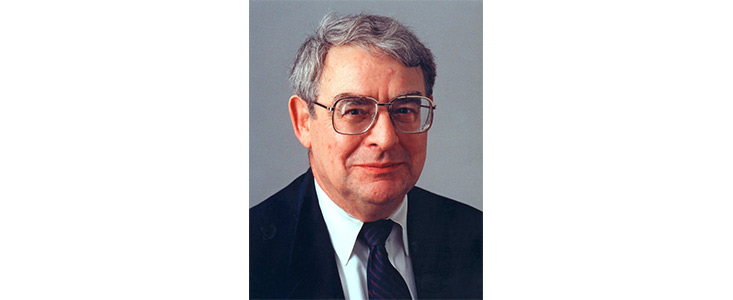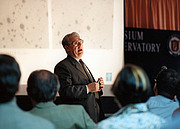Annonce
Riccardo Giacconi (1931–2018)
“Father of X-ray astronomy” and former ESO Director General key to the success of ESO’s Very Large Telescope has passed away
11 décembre 2018
ESO’s fifth Director General, Riccardo Giacconi, passed away on Sunday 9 December 2018 at the age of 87.
Riccardo Giacconi led ESO from 1993 to 1999, at a crucial time in the organisation’s history. ESO was constructing what is now its flagship facility, the Very Large Telescope (VLT), on Cerro Paranal, and starting the partnership that would become the Atacama Large Millimeter/submillimeter Array (ALMA). The successes of these years, and in particular the construction of the VLT, put ESO on the path to being the world-leading astronomical organisation that it is today.
Riccardo Giacconi was born in Genova, Italy on 6 October 1931. He obtained both a degree in Physics and his PhD from the University of Milan. In 1956, two years after receiving his PhD, Giacconi moved to Indiana University, USA and then on to Princeton University, USA to work at the Princeton Cosmic Ray Laboratory.
Following his time at Princeton, Giacconi began the work that earned him the title of “father of X-ray astronomy”. He was contracted by American Science and Engineering to initiate a space science programme, and Giacconi decided that the programme should focus on observations at X-ray wavelengths. This decision effectively marked the beginning of X-ray astronomy. In 1962, he and his group discovered Scorpius X-1, the first known X-ray source outside the Solar System, and the cosmic X-ray background.
“As an X-ray astronomer myself, Riccardo Giacconi and his work illuminated more than three decades of my career, long before I came to ESO,” commented Xavier Barcons, ESO’s current Director General. “I consider it a great honour to be one of his successors as Director General, at the organisation that he did so much to shape,”
During Giacconi’s time as ESO’s Director General he made significant changes to the organisation of ESO which were instrumental in making the VLT a success. In particular, his modern management techniques were well-suited to large programmes, and fostered greater collaboration between ESO and Chile. Thanks to his leadership, ESO was able to overcome significant technological and financial difficulties in building the VLT, and two of the four Unit Telescopes saw first light toward the end of his term.
During his tenure as Director General, he also oversaw further developments at La Silla — through his support, the New Technology Telescope (NTT) was improved. The NTT broke new ground for telescope engineering and design and was the first in the world to have a computer-controlled main mirror.
Upon leaving ESO, he returned to the United States to take up a post as President of Associated Universities Incorporated (AUI) in 2002. He was awarded a share of the Nobel Prize in Physics in 2002 “for pioneering contributions to astrophysics, which have led to the discovery of cosmic X-ray sources.”
Riccardo Giacconi’s contributions as Director General helped shape ESO into the world-leading organisation it has become, and his leadership will be remembered as instrumental for ESO’s enduring success.
A fuller obituary has been published in ESO's quarterly journal The Messenger.
Contacts
Calum Turner
ESO Public Information Officer
Garching bei München, Germany
Tel: +49 89 3200 6670
Email: pio@eso.org
À propos de l'annonce
| Identification: | ann18090 |
Our use of Cookies
We use cookies that are essential for accessing our websites and using our services. We also use cookies to analyse, measure and improve our websites’ performance, to enable content sharing via social media and to display media content hosted on third-party platforms.
ESO Cookies Policy
The European Organisation for Astronomical Research in the Southern Hemisphere (ESO) is the pre-eminent intergovernmental science and technology organisation in astronomy. It carries out an ambitious programme focused on the design, construction and operation of powerful ground-based observing facilities for astronomy.
This Cookies Policy is intended to provide clarity by outlining the cookies used on the ESO public websites, their functions, the options you have for controlling them, and the ways you can contact us for additional details.
What are cookies?
Cookies are small pieces of data stored on your device by websites you visit. They serve various purposes, such as remembering login credentials and preferences and enhance your browsing experience.
Categories of cookies we use
Essential cookies (always active): These cookies are strictly necessary for the proper functioning of our website. Without these cookies, the website cannot operate correctly, and certain services, such as logging in or accessing secure areas, may not be available; because they are essential for the website’s operation, they cannot be disabled.
Functional Cookies: These cookies enhance your browsing experience by enabling additional features and personalization, such as remembering your preferences and settings. While not strictly necessary for the website to function, they improve usability and convenience; these cookies are only placed if you provide your consent.
Analytics cookies: These cookies collect information about how visitors interact with our website, such as which pages are visited most often and how users navigate the site. This data helps us improve website performance, optimize content, and enhance the user experience; these cookies are only placed if you provide your consent. We use the following analytics cookies.
Matomo Cookies:
This website uses Matomo (formerly Piwik), an open source software which enables the statistical analysis of website visits. Matomo uses cookies (text files) which are saved on your computer and which allow us to analyze how you use our website. The website user information generated by the cookies will only be saved on the servers of our IT Department. We use this information to analyze www.eso.org visits and to prepare reports on website activities. These data will not be disclosed to third parties.
On behalf of ESO, Matomo will use this information for the purpose of evaluating your use of the website, compiling reports on website activity and providing other services relating to website activity and internet usage.
Matomo cookies settings:
Additional Third-party cookies on ESO websites: some of our pages display content from external providers, e.g. YouTube.
Such third-party services are outside of ESO control and may, at any time, change their terms of service, use of cookies, etc.
YouTube: Some videos on the ESO website are embedded from ESO’s official YouTube channel. We have enabled YouTube’s privacy-enhanced mode, meaning that no cookies are set unless the user actively clicks on the video to play it. Additionally, in this mode, YouTube does not store any personally identifiable cookie data for embedded video playbacks. For more details, please refer to YouTube’s embedding videos information page.
Cookies can also be classified based on the following elements.
Regarding the domain, there are:
- First-party cookies, set by the website you are currently visiting. They are stored by the same domain that you are browsing and are used to enhance your experience on that site;
- Third-party cookies, set by a domain other than the one you are currently visiting.
As for their duration, cookies can be:
- Browser-session cookies, which are deleted when the user closes the browser;
- Stored cookies, which stay on the user's device for a predetermined period of time.
How to manage cookies
Cookie settings: You can modify your cookie choices for the ESO webpages at any time by clicking on the link Cookie settings at the bottom of any page.
In your browser: If you wish to delete cookies or instruct your browser to delete or block cookies by default, please visit the help pages of your browser:
Please be aware that if you delete or decline cookies, certain functionalities of our website may be not be available and your browsing experience may be affected.
You can set most browsers to prevent any cookies being placed on your device, but you may then have to manually adjust some preferences every time you visit a site/page. And some services and functionalities may not work properly at all (e.g. profile logging-in, shop check out).
Updates to the ESO Cookies Policy
The ESO Cookies Policy may be subject to future updates, which will be made available on this page.
Additional information
For any queries related to cookies, please contact: pdprATesoDOTorg.
As ESO public webpages are managed by our Department of Communication, your questions will be dealt with the support of the said Department.



